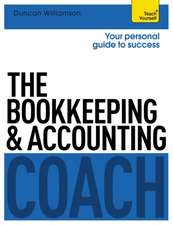Accountancy: AIB Textbook: Banking and Finance Series, cartea 2
R. Bryanten Limba Engleză Hardback – 31 oct 1985
Preț: 648.56 lei
Preț vechi: 763.01 lei
-15% Nou
Puncte Express: 973
Preț estimativ în valută:
124.10€ • 129.92$ • 102.69£
124.10€ • 129.92$ • 102.69£
Carte tipărită la comandă
Livrare economică 05-19 aprilie
Preluare comenzi: 021 569.72.76
Specificații
ISBN-13: 9780860105848
ISBN-10: 0860105849
Pagini: 356
Ilustrații: XVI, 356 p.
Dimensiuni: 178 x 254 x 20 mm
Greutate: 0.64 kg
Ediția:1985
Editura: SPRINGER NETHERLANDS
Colecția Springer
Seria Banking and Finance Series
Locul publicării:Dordrecht, Netherlands
ISBN-10: 0860105849
Pagini: 356
Ilustrații: XVI, 356 p.
Dimensiuni: 178 x 254 x 20 mm
Greutate: 0.64 kg
Ediția:1985
Editura: SPRINGER NETHERLANDS
Colecția Springer
Seria Banking and Finance Series
Locul publicării:Dordrecht, Netherlands
Public țintă
ResearchCuprins
1 Introduction to Accountancy.- The Users of Accounting Information.- Organisation of the Finance Function.- The Financial Statements.- The Interrelationships of the Financial Statements.- Accounts and the Banker.- This Book.- Further Reading.- 2 Accounting Principles and Practice I.- The Accounting Standards Committee.- The Accounting Requirements of the Companies Acts.- The Fundamental Concepts and Principles of Accounting.- Stocks and Work-in-Progress.- Standard accounting practice: stocks and work-in-progress (SSAP 9).- Long-Term Contract Work-in-Progress.- Long-term contract work-in-progress and the Companies Act 1981.- Base Stocks.- Research and Development Expenditure.- Foreign Currency Translation.- Conclusion: Accounting Principles and the Banker.- Further Reading.- 3 Accounting Principles and Practice II.- Depreciation and Accounting for Fixed Tangible Assets.- Accounting for Intangible Fixed Assets.- Accounting for Investments.- Accounting for Liabilities.- Accounting for Contingencies.- Accounting for Post Balance Sheet Events.- Conclusion: Significance for the Banker.- Further Reading.- 4 Taxation.- Corporation Tax.- Advance Corporation Tax.- Ascertaining Taxable Income.- Capital Gains.- Relief for Losses.- Close Companies.- Taxation of Partners and Sole Traders.- Deferred Taxation.- Franked and Unfranked Investment Income.- The Presentation of Taxation in Company Accounts.- Taxation and the Banker.- Further Reading.- 5 The Accounting Requirements of the Companies Acts.- The General Regulations Governing.- The Standard Formats for Accounts.- The Accounting Exemptions for Small and Medium-Sized Companies.- Distributable Profits under the Companies Acts.- The Disclosure of Transactions Involving Directors.- The Companies Acts and the Banker.- Further Reading.- 6 Group Accounts.- Accounting for Trade Investments.- Associated and Related Companies.- The Accounting Treatment of Associated Companies (SSAP 1).- Accounting for Groups of Companies.- Bookkeeping Procedures for Consolidation.- Provisions of the Companies Act Concerning Group Accounts.- Standard Accounting Practice — Group Accounts — (SSAP 14).- Merger and Acquisition Methods of Accounting for Amalagations.- Accounting for Foreign Currency Translations.- Conclusion: Group Accounts and the Banker.- Further Reading.- 7 Inflation and Accounting.- The Deficiencies of Historic Cost Accounting in a Period of Inflation.- SSAP 16 — Current Cost Accounting.- Criticisms of SSAP 16 in Practice.- The Statement of Intent and ED 35.- Current Cost Accounts and the Banker.- Further Reading.- 8 Interpretation of Financial Accounts.- Preliminary Examination of the Annual Report.- Ratio Analysis.- Empirical Research on the Predictability of Company Accounts.- Conclusion.- Further Reading.- 9 Management Accounting and the Analysis of Profit Performance.- Management Accounts and Financial Accounts.- Examining a Budget.- Costs and Costing.- Profit Volume Analysis.- Control.- Absorption Costing and Marginal Costing.- Conclusion.- Further Reading.- 10 Planning and Controlling Working Capital and the Flow of Funds.- The Flow of Funds within a Business: The Working Capital Cycle.- Planning the Flow of Funds.- Controlling the Flow of Funds.- Calculating the Working Capital Cycle.- Statement of Source and Application of Funds.- Conclusion.- Further Reading.- 11 Investment Decisions.- The Time Value of Money.- DCF Methods of Investment Appraisal.- The Internal Rate of Return.- The NPV and IRR Methods Compared.- Conventional Methods of Investment Appraisal.- DCF and Conventional Methods ofInvestment Appraisal Compound.- Risk and Uncertainty in Capital Investment.- Inflation and Investment Appraisal.- The Administrative Framework for Investment Decisions.- Conclusion: Investment Decisions and the Banker.- Further Reading.- 12 Financing Decisions.- The Criteria for Selecting Finance.- Options and Alternatives.- Calculating the Cost of Capital.- Conclusion.- Further Reading.- 13 Company Valuation.- Earnings per Share.- Investment Ratios.- The Valuation of Companies: Theoretical and Practical Approaches.- Valuation of Private Companies and Partnerships.- The Accountant’s Approach to Valuing Goodwill.- The Accountant’s Report.- The Gone Concern Valuation.- Conclusion.- Further Reading.- 14 Accounting for Reorganisations and Reconstructions.- Share Capital and Share Premium.- Redeemable Shares.- Purchase by a Company of its Own Shares.- Reconstructions, Reorganisation and Liquidations.- Appendix 1 Information to be Given as Notes to the Accounts in Accordance with the Companies Act.- Appendix 2 Present Value Table.








